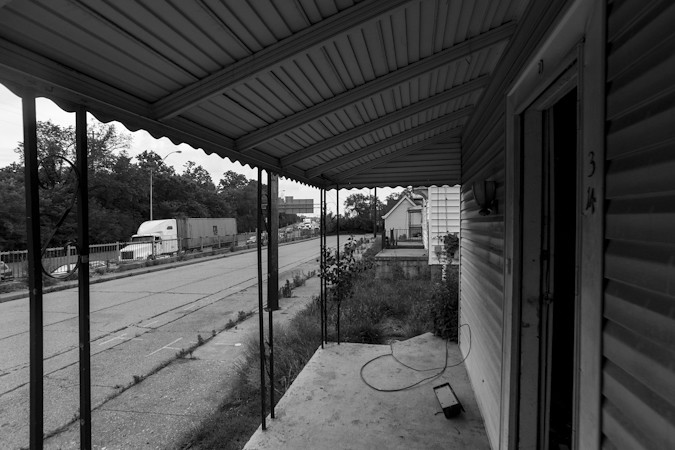 |
| - An abandoned residence in Lockland. Photograph by Ronny Salerno. |
Lockland is no stranger though to the advances of technology and transportation. It's a place that was born on the banks of a canal. Then the railroads came and then the automobile. The stagnant canal was drained, abandoned and converted into one of the area's first freeways - connecting Cincinnati to Lockland's wartime production industrial core. The bomb was dropped, our enemies surrendered and a victorious America emerged from World War Two with a booming economy and new sense of prosperity. From shining sea to shining sea, new multi-lane interstates began connecting our cities.
In 1941, the completion of the "Wright Highway" on top of what had once been the Miami-Eerie Canal provided a direct path straight into Lockland. Named for the village's Wright Aeronautical factory, the highway delivered an easy path for the thousands of workers manufacturing airplane engines. Today that plant is now the offices of General Electric.
With the passing of the National Interstate and Defense Highways Act of 1956, the Wright Highway became Interstate 75 as progress expanded it northward. The burgeoning suburban population of Cincinnati and rise of the automobile caused the highway to expand further, adding new lanes to handle the ever increasing traffic. In 1963, the "split" was born when new northbound lanes were constructed, causing the directional lanes of traffic to split around the village of Lockland. The only remaining portion of the Wright Highway that was left, is where the highway flows down into a valley of concrete retaining walls infamously known as "the trench."
 |
| - "Where the sidewalk ends." Just beyond the trees are the northbound lanes of I-75 that pass directly through the Village of Lockland and severed this sidewalk from the rest of the neighborhood. Photograph by Ronny Salerno. |
Cincinnati's highways are different than much of the rest of the nation though. They wind and twist through densely populated hills that surround the metropolis and feature narrow right-of-ways with precariously curved ramps. Yet, the highways had to grow to handle the ever increasing automobile traffic.
Walter Kulash once said that "Trying to cure congestion with more capacity is like trying to cure obesity by loosening your belt." Kulash, a traffic engineer from Orlando, is one of many vocal advocates to have emerged in the 21st century arguing against increasing the lanes of highways. In some parts of the nation, cities are actually
removing freeways and seeking out new alternatives. In Ohio though, we're currently sticking with the status quo as the "Thru the Valley" project continues at full pace, set to be completed in the fall.
The project will add four more lanes to I-75 and modernize many of the highway's awkward interchanges while adding sound barriers throughout the highway's path. In Lockland, this means the acquisition of numerous homes - the owners of which received fair market value for their property. Last week, QC/D reader Greg Spahr tipped me off about the Lockland homes currently being vacated and demolished.
 |
| - Photograph by Ronny Salerno. |
We toured the neighborhood streets that sit just feet from the highway and in some cases overlook it from atop the "trench." A few personal belongings remained scattered about, the addresses were still on the mailboxes and a backhoe loomed nearby on the freshly brought up dirt mound that used to be someone's home.
Through Lockland, the interstate grows again.
























